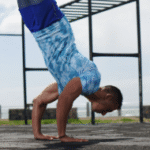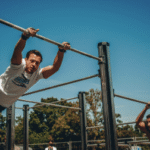Self-Taught Calisthenics vs Guided Private Sessions
- Self-Taught Calisthenics: The DIY Approach
This involves individuals learning calisthenics by themselves, typically relying on online resources such as YouTube videos, fitness apps, blogs, e-books, and social media tutorials. It’s often chosen for its accessibility and lower upfront cost.
Pros of Self-Taught Calisthenics:
Cost-Effectiveness: It’s the most budget-friendly option, requiring minimal to no direct payment for coaching.
Flexibility: You can train anytime, anywhere (your Houston home, a local park like Memorial Park or Buffalo Bayou Park, or an apartment gym), adapting workouts to your own schedule.
Self-Paced Learning: You dictate the speed at which you learn and progress.
Resource Abundance: The internet is flooded with calisthenics tutorials and programs.
Cons of Self-Taught Calisthenics (Where It Falls Short):
High Risk of Improper Form and Injury: This is the most significant drawback. Videos can demonstrate, but they cannot correct your specific form in real-time. Subtle misalignments, often imperceptible to the untrained eye, can lead to inefficient muscle activation, plateaus, and, critically, acute or chronic injuries (e.g., shoulder impingement, elbow tendonitis, wrist strain, lower back issues) that can derail your progress for months.
Inefficient Progression and Plateaus: Calisthenics is highly skill-based. Progression isn’t as simple as adding weight to a barbell. It involves mastering increasingly difficult exercise variations. Without expert guidance, it’s easy to get stuck on a plateau because you’re using ineffective progressions or not addressing specific weaknesses. Many self-taught individuals struggle to break down complex skills (like handstands, muscle-ups, planches, human flags) into manageable, safe steps.
Lack of Personalized Adaptation: A generic online program or video isn’t designed for your unique body. It won’t account for your specific muscle imbalances, mobility limitations, previous injuries, or how your body recovers. This can lead to overtraining certain areas while neglecting others, creating new imbalances.
Motivation and Accountability Issues: It’s easy to skip workouts or give up when progress is slow or frustrations mount. There’s no human element providing personalized encouragement, celebrating your unique milestones, or directly holding you accountable for showing up and putting in the work.
Difficulty in Self-Diagnosis: When you hit a roadblock or feel pain, it’s challenging to accurately diagnose the root cause without expert knowledge. Is it a strength deficit, a mobility issue, a form error, or overtraining? A self-taught individual might waste weeks or months on ineffective solutions.
Overwhelm from Information Overload: The sheer volume of conflicting advice online can be overwhelming, making it difficult to discern reliable information from misleading or unsafe practices.
—
- Guided Private Sessions: The Expert-Led Path
This involves working one-on-one with a certified and experienced calisthenics personal trainer. This approach is highly personalized and focuses on safety, efficiency, and mastery.
Pros of Guided Private Sessions (Where It Excels):
Meticulous Form Correction and Injury Prevention (The Gold Standard): A private coach provides constant, real-time, in-person feedback. They can spot exactly where your form breaks down, identify muscle imbalances, and make immediate, precise adjustments. This is invaluable for preventing injuries, ensuring proper muscle activation, and building a strong, safe foundation for complex skills.
Hyper-Personalized Programming and Dynamic Adaptation: Your coach will conduct a comprehensive assessment to understand your strengths, weaknesses, mobility, injury history, and specific goals. They will design a bespoke program that is constantly adapted based on your progress, fatigue levels, and individual needs. If you hit a plateau, they know exactly how to adjust the program to push you forward.
Accelerated Skill Mastery: Calisthenics skills are complex. A specialized coach can break down advanced movements (e.g., handstands, muscle-ups, human flags) into logical, progressive steps. They provide targeted drills, specific cues, and safe spotting, accelerating your learning curve significantly and helping you achieve feats that might seem impossible on your own.
High Accountability and Motivation: Having a dedicated coach waiting for you at a scheduled session in a Houston gym or park creates strong accountability. They provide tailored encouragement, track your specific progress, and help you overcome mental barriers, keeping you motivated and consistent.
Efficiency and Time Optimization: Every minute of a private session is dedicated to your progress. There’s no wasted time researching exercises, setting up equipment, or struggling with form. The coach ensures you’re performing exercises correctly and effectively, leading to faster, more noticeable results.
Targeted Weakness Identification and Correction: A coach can accurately diagnose muscle imbalances or mobility restrictions that are hindering your progress or causing pain, then prescribe specific exercises to address them.
Cons of Guided Private Sessions:
Higher Cost: This is the primary drawback. Private coaching is a significant investment per session compared to self-taught methods or even group classes. However, many see it as an investment in faster, safer, and more effective results.
Less Schedule Flexibility (within the session itself): You need to adhere to scheduled appointments with your trainer.
Less Social Interaction (during the session): The focus is solely on you and the coach, which some might find less engaging than a group environment.
—
Houston Context for Both Approaches
Self-Taught in Houston: Easy to do. Houston’s numerous parks (like Memorial Park, Buffalo Bayou Park, Discovery Green) often have pull-up bars and open spaces. Many apartment complexes have basic gyms suitable for fundamental calisthenics. The convenience aligns with Houston’s busy lifestyle.
Guided Private Sessions in Houston: You’ll find specialized calisthenics studios (e.g., in areas like Montrose, The Heights), independent mobile trainers who can meet you at parks or your home gym, and even some larger gyms with trainers who specialize in bodyweight fitness. Houston’s diverse fitness market offers various options for finding a qualified private coach.
Conclusion: Which is Right for You?
While self-taught calisthenics offers accessibility and low direct cost, it carries significant risks of injury, inefficiency, and frustration, especially when aiming for advanced skills. The lack of personalized feedback and expert guidance often leads to slow or stalled progress.
Guided private sessions, although a higher financial investment, offer unparalleled value in terms of:
Safety: Minimizing injury risk through meticulous form correction.
Efficiency: Accelerating skill acquisition and strength gains with tailored programming.
Accountability: Keeping you motivated and consistent.
Specific Goal Achievement: Providing the exact roadmap and coaching needed to master complex calisthenics feats.
For anyone serious about mastering calisthenics, preventing injuries, or breaking through plateaus, especially when starting or attempting advanced movements, guided private sessions are overwhelmingly the superior choice. They transform a potentially haphazard journey into a structured, safe, and highly effective path towards achieving your bodyweight fitness goals in Houston.

Self-Taught Calisthenics vs Guided Private Sessions
Route
Calisthenics Gym Houston Functional Bodyweight Training
Secondary phone: (346) 483-3195
Email: info@calisthenicsclubhouston.com
URL: https://calisthenicsclubhouston.com/
Monday 6:00 AM - 7:00 PM Tuesday 6:00 AM - 7:00 PM Wednesday 6:00 AM - 7:00 PM Thursday 6:00 AM - 7:00 PM Friday 12:00 PM - 6:30 PM Saturday 9:45 AM - 12:00 PM Sunday 3:00 PM - 5:00 PM





